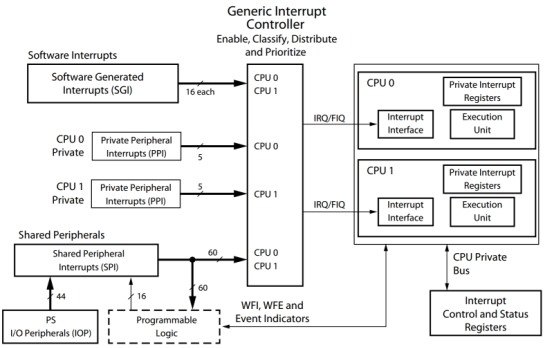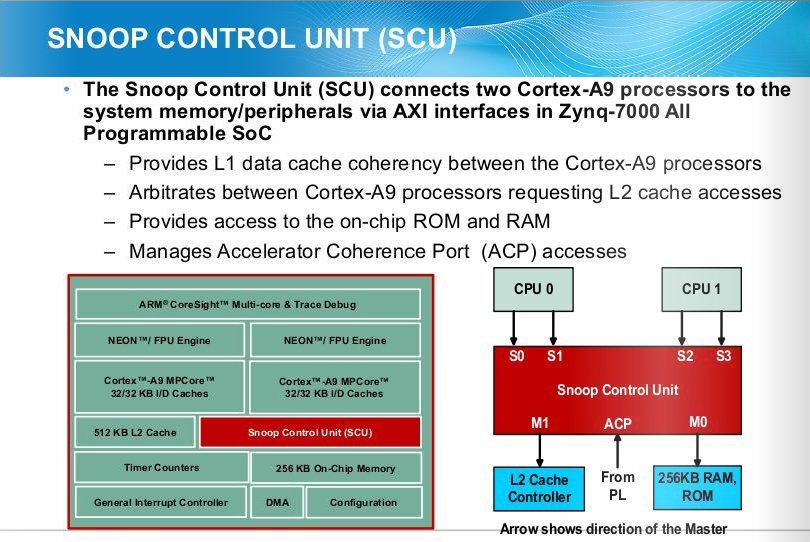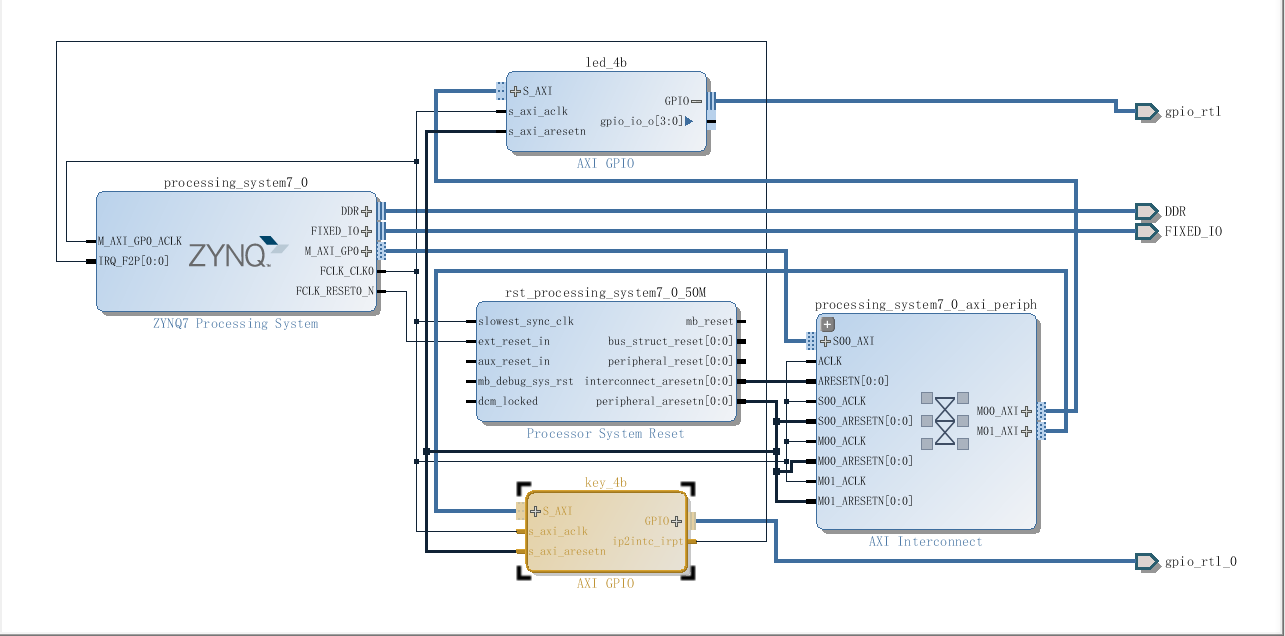zynq_定时器中断
@(study)[大学生活, markdown_study, LaTex_study]
[TOC]
zynq的中断体系结构框图

中断控制器(GIC)
在zynq中的中断控制比较复杂,主要是因为中断接收端有两个cpu,涉及到cpu的中断协同问题,中断的发起端除了常见的之外还有PL端哔哩吧啦一大推.
见官方文档chapter_8别慌,问题不大
All interrupt sources are identified by a unique interrupt ID number.All interrupt sources have their own configurable priority and list of targeted CPUs –chapter7_interrupt
SGI: Software Generated Interrupts 软件中断 16个
SPI: Shared Peripheral Interrupts 共享(PS/PL)外设中断 60个
PPI: Private Peripheral Interrupts 私有中断 每个cpu各5个,计数时钟为主频一半
FIQ: Fast inte
rrupt request 快速中断响应
IRQ: interrupt request 中断响应
实现一个简单的一秒PPI
正确认识下,一个PPI是纯PS端的,也就是说他只是我们说的简单的单片机的中断而已.
1. 新建一个纯PS工程,并导入SDK,挑选helloworld模板和生成bps(见前面的博客)
- 将heloworld.c
#include <stdio.h>
#include "xadcps.h"
#include "xil_types.h"
#include "Xscugic.h"
#include "Xil_exception.h"
#include "xscutimer.h"
#define TIMER_DEVICE_ID XPAR_XSCUTIMER_0_DEVICE_ID
#define INTC_DEVICE_ID XPAR_SCUGIC_SINGLE_DEVICE_ID
#define TIMER_IRPT_INTR XPAR_SCUTIMER_INTR
//加载计数周期,私有定时器癿时钟为CPU癿一般,为333MHZ,如果计数1S,加载值为1sx(333x1000x1000)(1/s)-1=0x13D92D3F
#define TIMER_LOAD_VALUE 0x13D92D3F //一秒
static XScuGic Intc;
static XScuTimer Timer;
static void SetupInterruptSystem(XScuGic *Gicptr , XScuTimer *timerptr ,u16 TimerIntrId); //中断注册函数
static void TimerIntrHandler(void *CallBackRef);
//#include "platform.h"
//void print(char *str);
int main()
{
XScuTimer_Config *TMRConfigPtr;
printf("start/n");
//PPI setup
TMRConfigPtr = XScuTimer_LookupConfig(TIMER_DEVICE_ID);
XScuTimer_CfgInitialize(&Timer, TMRConfigPtr,TMRConfigPtr->BaseAddr);
XScuTimer_SelfTest(&Timer);
//加载计数周期,私有定时器的时钟为CPU的一半,为333MHZ,
//如果计数1S,加载值为1sx(333x1000x1000)(1/s)-1=0x13D92D3F
XScuTimer_LoadTimer(&Timer, TIMER_LOAD_VALUE);
//自劢装载
XScuTimer_EnableAutoReload(&Timer);
//启劢定时器
XScuTimer_Start(&Timer);
//set up the GIC
SetupInterruptSystem(&Intc,&Timer,TIMER_IRPT_INTR);
while(1){};
return 0;
}
void SetupInterruptSystem(XScuGic *Gicptr , XScuTimer *timerptr ,u16 TimerIntrId)
{
XScuGic_Config *IntcConfig; //GIC config
Xil_ExceptionInit();
IntcConfig = XScuGic_LookupConfig(INTC_DEVICE_ID);
XScuGic_CfgInitialize(Gicptr, IntcConfig, IntcConfig->CpuBaseAddress);
//connect to the hardware
Xil_ExceptionRegisterHandler(XIL_EXCEPTION_ID_INT, (Xil_ExceptionHandler)XScuGic_InterruptHandler, Gicptr);
//set up the timer interrupt
XScuGic_Connect(Gicptr, TimerIntrId,
(Xil_ExceptionHandler)TimerIntrHandler,
(void *)timerptr);
//enable the interrupt for the Timer at GIC
XScuGic_Enable(Gicptr, TimerIntrId);
//enable interrupt on the timer
XScuTimer_EnableInterrupt(timerptr);
// Enable interrupts in the Processor.
Xil_ExceptionEnableMask(XIL_EXCEPTION_IRQ);
}
static void TimerIntrHandler(void *CallBackRef)
{
static int sec=0;
XScuTimer *timerptr = (XScuTimer *)CallBackRef;
XScuTimer_ClearInterruptStatus(timerptr);
sec++;
printf(" %d Second\n\r",sec); //每秒打印输出一次
}- 下载到板子上面
做一点简单的解释
为什么gic和timer前面都会带有一个SCU
见手册第三章3.3
SCU: snoop control unit (窥探控制单元?)
再看回上一篇博客的block manager那张图,我们可以看到GIC和SCU是连在一起的!

可以看到,SCU主要是解决ARM的L1和L2的缓存协调(因为两个processor的缓存是共用的)
和AXI总线的ACP存取的,也就是DMA等高速中断需求的外设
流程
- 设置定时器
通过ID号查配置->配置写入->初始化->加入预加载值->开启自动重载->开启定时 设置GIC
传入定时器配置->通过ID号查配置->配置写入->注册处理函数->定时器中断信号和中断函数连接->使能定时器中断
->使能中断->使能处理器处理中断差不多就是一个流程对应一个函数这样子
ID号可以在
xparameters.h里面找到- 函数(API)可以在bps里面的system.mss里面的每一个模块的docs里面找到
PS和PL共享中断
也就是图上所说的SPI(Shared Peripheral Interrupts)
同前面的PS-PL协同开发的项目新建
- 加入一个GPIO1,全部输入,使能中断

- 再加入一个gpio0作led灯用

- 同协同项目流程一致,封装,生成bit~~~~~
- 导入sdk,新建bsp
hello源码
#include "xparameters.h"
#include "xscugic.h"
#include "xil_exception.h"
#include "xgpio.h"
// Parameter definitions
#define INTC_DEVICE_ID XPAR_PS7_SCUGIC_0_DEVICE_ID
#define LED_DEVICE_ID XPAR_GPIO_1_DEVICE_ID
#define BTNS_DEVICE_ID XPAR_GPIO_0_DEVICE_ID
#define INTC_GPIO_INTERRUPT_ID XPAR_FABRIC_KEY_4B_IP2INTC_IRPT_INTR
#define BTN_INT XGPIO_IR_CH1_MASK // This is the interrupt mask for channel one
XGpio LED;
XGpio BTNInst;
XScuGic INTCInst;
static u8 btn_value;
//----------------------------------------------------
// PROTOTYPE FUNCTIONS
//----------------------------------------------------
static void BTN_Intr_Handler(void *baseaddr_p);
static int InterruptSystemSetup(XScuGic *XScuGicInstancePtr);
static int IntcInitFunction(u16 DeviceId, XGpio *GpioInstancePtr);
//----------------------------------------------------
// INTERRUPT SERVICE ROUTINE(ISR)
//also know as : INTERRUPT HANDLER FUNCTION
// - called by the buttons interrupt, performs push buttons read
//----------------------------------------------------
void BTN_Intr_Handler(void *InstancePtr)
{
unsigned char led_val = 0;
// Ignore additional button presses
if ((XGpio_InterruptGetStatus(&BTNInst) & BTN_INT) !=
BTN_INT) {
return;
// Disable GPIO interrupts
XGpio_InterruptDisable(&BTNInst, BTN_INT);
}
btn_value = ~XGpio_DiscreteRead(&BTNInst, 1)&0x0f;
switch (btn_value){
case 0x01: led_val = 0x01; break;
case 0x02: led_val = 0x02; break;
case 0x04: led_val = 0x04; break;
case 0x08: led_val = 0x08; break;
default:break; }
XGpio_DiscreteWrite(&LED,1,~led_val);
// Acknowledge GPIO interrupts
(void)XGpio_InterruptClear(&BTNInst, BTN_INT);
// Enable GPIO interrupts
XGpio_InterruptEnable(&BTNInst, BTN_INT);
}
//----------------------------------------------------
// MAIN FUNCTION
//----------------------------------------------------
int main (void)
{
int status;
// 初始化按键
status = XGpio_Initialize(&BTNInst, BTNS_DEVICE_ID);
if(status != XST_SUCCESS) return XST_FAILURE;
//初始化LED
status = XGpio_Initialize(&LED, LED_DEVICE_ID);
if(status != XST_SUCCESS) return XST_FAILURE;
// 设置按键IO的方向为输入
XGpio_SetDataDirection(&BTNInst, 1, 0xF);
//设置LED IO的方向为输出
XGpio_SetDataDirection(&LED, 1, 0x00);
//设置LED 灯熄灭
XGpio_DiscreteWrite(&LED,1,0x0f);
// 初始化按键的中断控制器
status = IntcInitFunction(INTC_DEVICE_ID, &BTNInst);
if(status != XST_SUCCESS) return XST_FAILURE;
while(1){
}
return (0);
}
//----------------------------------------------------
// INTERRUPT SETUP FUNCTIONS
//----------------------------------------------------
int IntcInitFunction(u16 DeviceId, XGpio *GpioInstancePtr)
{
XScuGic_Config *IntcConfig;
int status;
// Interrupt controller initialization
IntcConfig = XScuGic_LookupConfig(DeviceId);
status = XScuGic_CfgInitialize(&INTCInst, IntcConfig, IntcConfig->CpuBaseAddress);
if(status != XST_SUCCESS) return XST_FAILURE;
// Call interrupt setup function
status = InterruptSystemSetup(&INTCInst);
if(status != XST_SUCCESS) return XST_FAILURE;
// Register GPIO interrupt handler
status = XScuGic_Connect(&INTCInst,
INTC_GPIO_INTERRUPT_ID,
(Xil_ExceptionHandler)BTN_Intr_Handler,
(void *)GpioInstancePtr);
if(status != XST_SUCCESS) return XST_FAILURE;
// Enable GPIO interrupts
XGpio_InterruptEnable(GpioInstancePtr, 1);
XGpio_InterruptGlobalEnable(GpioInstancePtr);
// Enable GPIO interrupts in the controller
XScuGic_Enable(&INTCInst, INTC_GPIO_INTERRUPT_ID);
return XST_SUCCESS;
}
int InterruptSystemSetup(XScuGic *XScuGicInstancePtr)
{
// Register GIC interrupt handler
Xil_ExceptionRegisterHandler(XIL_EXCEPTION_ID_INT,
(Xil_ExceptionHandler)XScuGic_InterruptHandler,
XScuGicInstancePtr);
Xil_ExceptionEnable();
return XST_SUCCESS;
}
程序也算是很简单了,看到他的初始化流程是先初始化一个指针去查找ID对应的配置,然后用一个函数写入就完事了..